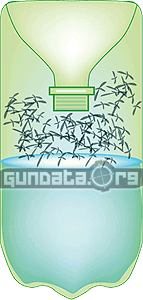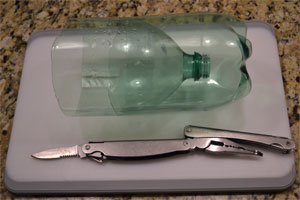How to Make Homemade Mosquito Trap
Article Posted: August 8, 2013
Attributed to Confucius - "Do not use a cannon to kill a mosquito"
While its debatable whether Confucius ever said that or not, the fact is mosquitos are not only annoying and their sting/bite hurts, they can transmit diseases from animals to humans, humans to animals and human to human. Some of these diseases are quite deadly, including West Nile Virus, Yellow Fever, Eastern equine encephalitis and Western equine encephalitis (EEE and WEE are considered especially deadly). Even though HIV transmission via mosquitos has been proven false by the CDC, the other diseases they transmit are reason enough to try to ensure you never get bitten.
While mosquito repellents, especially those with DEET are quite capable of ensuring they don't get close, there are situations where using a mosquito repellent isn't reasonable. This can be because of clothing being worn, the number of people present or simply the lack of desire to smell like mosquito repellent. Fortunately, there are alternatives such as the use of mosquito traps. While commercial traps are available, it is quite easy to make a fairly effective and inexpensive homemade mosquito trap.
Constructing The Mosquito Trap
The ingredients and steps are quite simple and are things you probably have on hand already.
Most often, a 2 liter bottle is used although 1 liter bottles done the same way are effective as well.
For every 2 liters worth of containers used you'll need:
- 1 cup water (hot)
- 1/4 cup sugar (Brown sugar is suggested such as Domino's Dark Brown Sugar)
- 1 gram yeast (i.e.. Fleischmann's)
- Black wrapping such as a black trash bag, construction paper, etc.
The Steps

End Result "Trapped Mosquitos"
- 1.) Cut the top half of the bottle away but keep the top part for later
- 2.) Combine brown sugar and hot water. Stir to dissolve brown sugar into the water and allow to cool.
- 3.) Once cool, pour into container(s) (equal parts for 1 liter bottle, all of it for a 2 liter bottle
- 4.) Distribute yeast the same way. (half a gram per 1 liter, full gram for 2 liter). There is no need to stir in the yeast.
- 5.) Invert the top of the bottle and insert into the bottom half, creating a funnel and tape in place, creating a seal around the top.
- 6.) Cover outside of trap with black material, leaving the top open.
- 7.) Put in area to be protected from mosquitos or in an area with a high mosquito infestation
Either make new traps or refresh ingredients every two weeks to maintain effectiveness.
How The Trap Works
Mosquitos are attracted to three things involved in the construction of these traps:
- Black
- Sugar
- Carbon Dioxide
The combination of the brown sugar and the yeast not only gives off a sugary odor, it also creates a chemical reaction that produces carbon dioxide. Both the sugar and the carbon dioxide attract mosquitos and the black wrapping is also attractive to them.
Creating a funnel out of the top of the bottle allows the mosquito in, but prevents them from easily escaping before they either succumb to the carbon dioxide or starvation. By creating a seal at the top of the bottle around the cut with tape, you accomplish 2 things. First, you prevent the carbon dioxide from escaping and you also prevent gaps where mosquitos can escape.
The effectiveness of the yeast and brown sugar water is only good for up to 2 weeks so replacing the trap will be necessary. If you do a lot of outdoor grilling or like to sit outside during the evenings, finding some way to keep the mosquitos away is a must. An inexpensive and easy to make mosquito trap like this could very well be your answer!
Related Articles
Please like, share, favorite, bookmark, and comment. Thank You.
Main Menu
Original Articles
- New 25+1 Capacity Shotgun!
- Hudson H9 American Made 9mm
- How To Build A Mud Hut
- Pistol Looks Like Cell Phone
- 45 ACP vs 9mm Luger
- Best 9mm Carbines
- Mall Ninja Xtreme Zombie Carbine!
- 5 Alternative Range Bags for Pistols
- Best 45 ACP Carbines
- 5 Dirt Cheap Guns $170 to $260
- Muslim Free Shooting Range?
- How To Clean A Rifle
- 3 Good 300 AAC Blackout Reviews
- Top 5 Guns for Women
- How to Really Shoot A Pistol
- Worlds Best 9mm Handgun
- 5 Great Gun Safes (Options)
- 9mm vs 40 S&W Summary + Ballistics
- Red Oak, White, or Chestnut for Deer Herd?
- Bullets for Barter Post Collapse
- Funny Pro Gun Sayings
- 5 Strange Handguns You Don't Need
- 3 Great .22LR / 410 Survival Rifles
- American Rifles | The Original ARs
- 600 Round Glock Magazine
- 10mm vs 40 Summary and Ballistics
- How Important is "Shot Placement"?
- 10 Item First Aid Kit Checklist
- 10 Gun Lights for Home Defense
- How to Make a Stove Hobo Style!
- Most Basic Survival Food List Ever
- Best Handguns for Women
- Make Homemade Mosquito Trap
- Lets make a Sawed-Off Shotgun!
- Man Brings Knife to Gun Fight (Funny)
- Gun Store Etiquette (Proper vs Improper)
- 10 Simple Home Security Tips
- SIG-Sauer vs Glock
- Legal Length of Shotguns and Rifles
- 9mm Pocket Pistols
- Glock 17/19/26 Operating Procedures
- 10 Conceal Carry Tips (Funny)
- Understanding the 2nd Amendment
- Choose Your Own Crime Stats
- After You Dial 911 : Dont Be A Victim
- Does Gun Control Work?
- Best Shotgun Ammo for Self Defense
- Best Calibers for Self Defense
- FBI Handgun Ballistics
- 38 Special vs 380 ACP
- Top 5 Home Defense Handguns
- 5 Best Home Defense Shotguns
- How to Sight in a Scope - Step by Step Guide
- .380 ACPs Stopping Power (Funny)
- AK-47 vs AR-15 History and Facts
- A Bug Out Bag Checklist for 2015
- 30-06 vs. 270 Win
- Gun Stores
Ballistics Tools & Data
- Ballistic Trajectory Calculator
- Ballistic Coefficient Calculator
- 9mm Ballistics Chart
- 308 Ballistics Chart
- 30-06 Ballistics Chart
- .270 Win Ballistics Chart
- 30-30 Ballistics Chart
- 7.62x39mm Ballistics Chart
- 7mm Rem Magnum Ballistics Chart
- 17 HMR Ballistics Chart
- 223 Ballistics Chart
- .243 Ballistics Chart
- 22-250 Ballistics Chart
- Convert FPS to MPH











